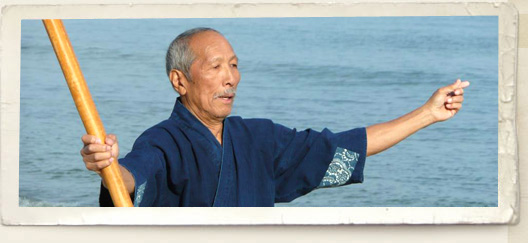
Sensei Kimiyoshi Suzuki
 Suzuki
sensei, the XVII. Grandmaster of our style, founder of the Shinbukan,
grandson of Makita Shigekatsu, was born on 1th January 1934 in Japan.
When he was a child everybody who did not practice some kind of martial
art was considered week or ill. Although it was not obligatory to practise
one, it was a common expectation. At the beginning he started to learn
Judo with his elder brother. At the age of five he has begun his studies
in Jikishin Kage-ryu Kenjutsu under Yokokawa sensei, which he still practices
and teaches up to now. The ryubi technique - which is a characteristic
of this style - was taught for the students from the beginning. Yokokawa
Sensei himself learnt the style from Nomi Hamao sensei, who is the uncle
of Ishigaki sensei. Yashuzou Ishigaki sensei is the XVII. Grandmaster
of the other branch of Jikishin Kage-ryu Kenjutsu called Nomi-ha, and
personal acquaintance of Suzuki sensei.
Suzuki
sensei, the XVII. Grandmaster of our style, founder of the Shinbukan,
grandson of Makita Shigekatsu, was born on 1th January 1934 in Japan.
When he was a child everybody who did not practice some kind of martial
art was considered week or ill. Although it was not obligatory to practise
one, it was a common expectation. At the beginning he started to learn
Judo with his elder brother. At the age of five he has begun his studies
in Jikishin Kage-ryu Kenjutsu under Yokokawa sensei, which he still practices
and teaches up to now. The ryubi technique - which is a characteristic
of this style - was taught for the students from the beginning. Yokokawa
Sensei himself learnt the style from Nomi Hamao sensei, who is the uncle
of Ishigaki sensei. Yashuzou Ishigaki sensei is the XVII. Grandmaster
of the other branch of Jikishin Kage-ryu Kenjutsu called Nomi-ha, and
personal acquaintance of Suzuki sensei.
Due to the war Suzuki sensei had to interrupt his studies in all martial arts. After the war he continued to practice Judo as well, which was a very popular style already at that time. Among the practitioners in their dojo there were at least fifty children and many adults. Even as a child he attended at several Kangeiko, where they trained early in the morning despite the great winter cold.
As a high school student he learnt karate for a while. Later on he joined the Goyu-ryu Karate club at the university, where Yamaguchi Gogen sensei shown up occasionally and Suzuki sensei began to train at his club as well. Gogen sensei usually did not teach, only oversaw the trainings and corrected some movements.
In the 1950s it was possible to start the trainings in the dojos again. At first in karate and judo but later on in other styles as well. In the time of Gogen sensei there were many students. Oyama sensei, the founder of Kyokushinkai Karate also visited his classes. When Oyama opened his first dojo many of this group helped him including Suzuki sensei.
After the university Sensei worked for a newspaper publisher for two years. Then, for the request of his father, he started to work in his photo studio from 1959. It was the time when he began to learn Aikido from Tada Hireoshi, who was the pupil of Ueshiba Morihei. Suzuki sensei had trained at his dojo until 1991, but he did not take exams. Tada sensei is really famous in Japan. He executes the techniques of aikido more forcefully then other masters.
In time Suzuki sensei became a trainer in the karate club of the university. Back then he did not have enough time to start an own club. In March, April and May he usually had to work from the morning to the next morning in the studio. In the meanwhile he got married. He has a daughter and a grandchild.
Fumio Murakami, who is the friend of Sensei, learnt Komagawa Kaishin-ryu
Kenjutsu from Kuroda sensei. He taught Suzuki sensei for the Yodare Sukashi
kata, which is a very difficult exercise. The Kaishin-ryu originates from
the Shinkage-ryu style as well, so it's moves similar to those in Jikishin
Kage-ryu Kenjutsu.
It was in 1986 when Suzuki sensei met Hungarian artists who visited Japan. As a response to their invitation he arrived in Budapest first, and later on in Pécs. By that time he became a widower and this ulterior place was where he met his future second wife. In 1992 he has finally settled down in this town. In that year there was a Japanese cultural event, where he held a display along with his three friends from Japan. Due to this a few students from his neighbourhood visited him and he started to teach them at his home. He opened the Shinbukan dojo in 1993, where he taught only Goju-ryu Karate at first. He has begun to teach Kenjutsu in 1998. Nowadays there are trainings in many countries following his teaches.

Suzuki sensei held a display at the monument erected in honour of his grandfather in the autumn of 2006, on the island of Hokkaido. The display, which was mentioned in the Japanese press, took place in the Shinto shrine next to the monument.

